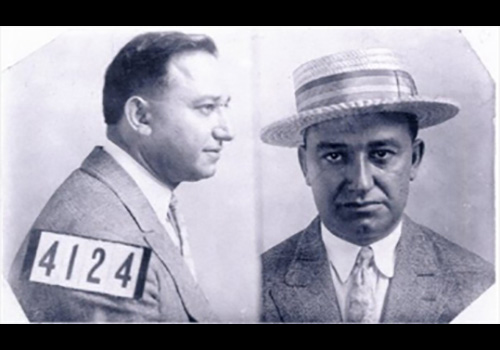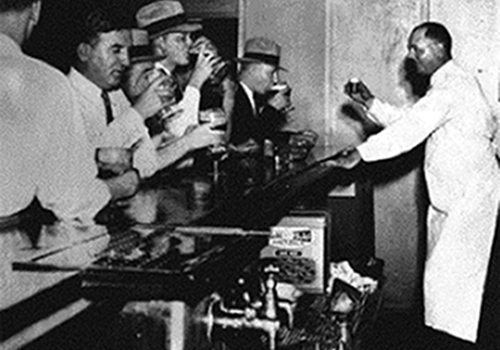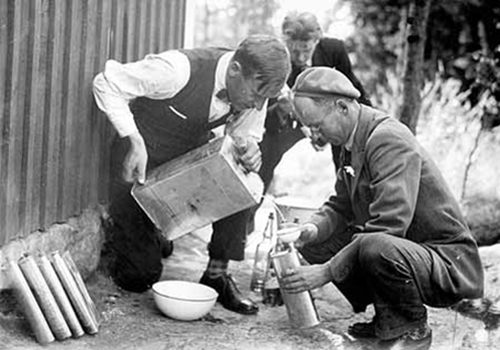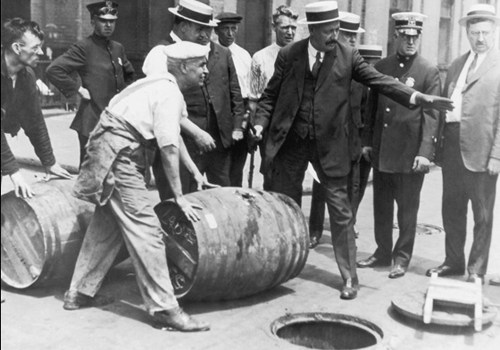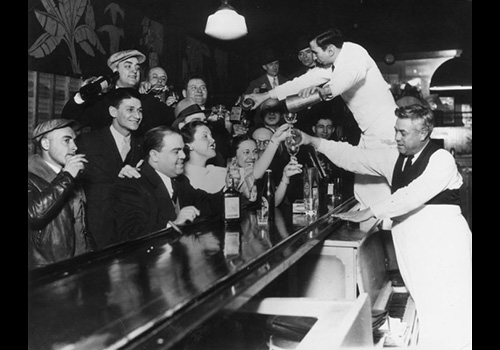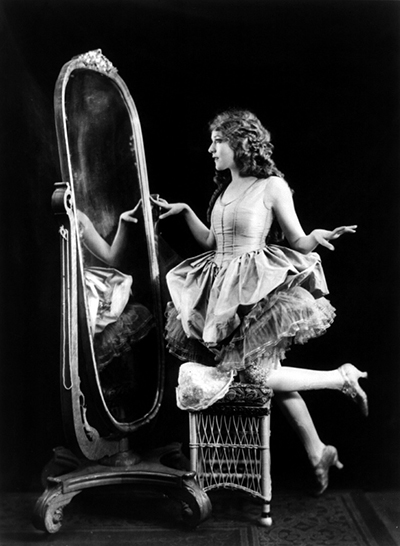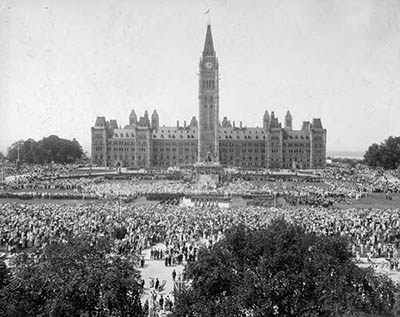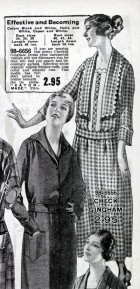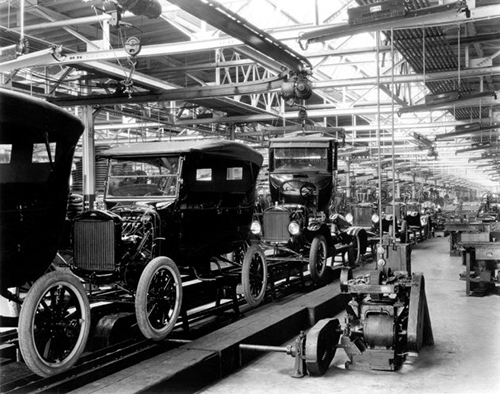Introduction
The decade of 1920–1929 is often called the “Roaring Twenties.” It was a decade that roared with a booming economy, new inventions, progress in women’s rights, and a vibrant arts scene.
The prohibition of alcohol was also introduced and had been instigated mostly by the temperance movement.
Canada had to shift from a full production war economy to a more balanced peacetime, supply-and-demand economy. At first, this caused a slump in the economy, until business activity levelled itself allowing the economy to regain its balance.
- Business activity started to improve.
- Discussions about fair wages, social responsibility, and democracy for everyone began.
- Labour movements started up.
- Farm co-operatives were formed.
- The economy began to shift from a rural, agricultural base to an urban, manufacturing base.
Economic growth in the U.S. continued to speed up throughout the 1920s, and Canada’s economy followed along. The positive trend affected regions which relied on manufacturing and production. Agricultural and resource-based industries did well as long as production was good and demand was high. However, many of the resources used to fuel manufacturing, agricultural and mining growth came at the cost of Indigenous treaties and land claims.
Governments pulled out of most large wartime programs. The thinking was that private industry ran business better than the government could. The federal government’s focus shifted to industry regulation, and Canada’s economy continued to grow.
The affluent economy of the 1920s encouraged innovation. Radios, snowmobiles, and improved air travel are some of the inventions which appeared at that time.
The positive energy and excitement of the time provided an excellent platform for the development of women’s rights.
Prohibition was also a significant, but temporary, change. The national government passed a law that made it illegal to produce or buy alcohol in Canada. It was considered a “blip” in Canada’s history, but exploring why it happened, why it ended, and how it impacted Canadians will give you some insight of Canadian society at the time.
The entertainment and leisure industries also transformed and expanded greatly in the 1920s. This will include popular movies, arts, and music of the times.
The following are a few other revealing facts about the 1920s:
- In 1920, one family in four had a telephone; by 1929, two out of four families had one.
- In 1921, 55 percent of Canadians lived outside cities; by 1929, over half lived in cities.
- In 1919, there were about 100 golf courses in Canada; by 1925, there were 292.
What you will learn
After completing this learning activity, you will be able to:
- Identify economic changes in different regions in Canada
- identify some major developments in science and technology during this period, and assess their historical significance
- explain the goals and accomplishments of some groups and/or movements that contributed to social and/or political cooperation during this period (for example, temperance organizations, women’s suffrage organizations, and the Famous Five)
- describe some significant changes in the arts and popular culture in Canada in the 1920s
- organize relevant evidence and information from a variety of primary and secondary sources
Canada’s Changing Economy
The 1920s witnessed many changes to the lives of Canadians.
Although called the ‘Roaring Twenties,’ 1920-1924 actually witnessed a weaker economy in Canada. After the war, exports from Canada to the United States were lower than they had been because of US tariffs. Similarly, in the early 20s, the Western provinces suffered a severe drought that hurt farmers.
However, by the 1924, the 20s began to roar with economic growth. The drought in the west had ended, trade barriers with the US had fallen and investment in the Canadian economy started to grow.
Join the discussion
Although the Roaring Twenties increased the overall economic prosperity of Canada, the impact was different in different communities across the country. In this activity, we’ll explore those differences in each region of Canada.
In groups, choose one of the regions of Canada:
- Maritimes (Nova Scotia, New Brunswick, PEI)
- Central Canada (Ontario, Quebec)
- Prairies (Manitoba, Saskatchewan, Alberta)
- British Columbia
- Northern Territories (Yukon, North West Territories)
In your groups, explore how the economies of each region changed. As you research and gather information, consider organizing your research by answering the following questions:
- How did the primary industries of this region change? (Mining, Farming, Fishing)
- How did the secondary industries of this region change? (Manufacturing, Construction, Transportation)
- How did these economic changes impact First Nations, Metis and Inuit communities in these regions?
Make sure to record your sources.
As a group, create a short presentation to share with your class in the forum. You might want to create a slide presentation, video, poster, or infographic to communicate your research.
Post your presentation to the forum to share with your classmates.
Respond to other students’ posts. In your opinion, did that region benefit from the Roaring Twenties overall?
Technology and invention
Technology and invention changed life in Canada in the 1920s and beyond. You’ll analyze some inventions of the 1920s using the concept of continuity and change to examine which had lasting impacts.
Four key inventions of the 1920s are described in the sections that follow. Your job is to estimate how much change resulted from each invention. Use the following scale to rate the degree of change that each invention brought.
| 4 | 3 | 2 | 1 |
|---|---|---|---|
| complete change (no continuity) |
moderate change | minimal change | no change (continuity) |
Then, you will have to justify your rating. In your justification, try to mention where the invention stands today. As an example, the first invention has been done for you.
Inventions of the 1920s
Radio
Edward (Ted) Samuel Rogers invented the battery-less radio/AC tube in 1923.
Today: “Rogers Communications remains a Canadian icon in the telecommunications industry to this day.”
Source: Coyler, Jill. Canadian Sources Investigated. Toronto: Emond Montgomery, 2010. 37.
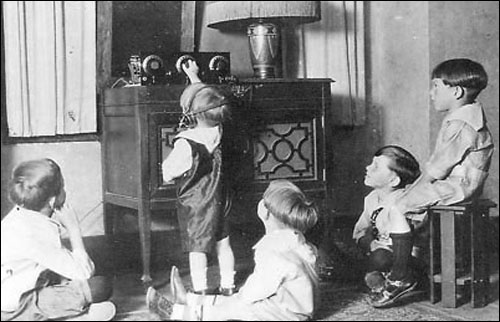
Children listen to a radio program in the 1920s.
Who used radios?
Families bought radios for entertainment and information. The whole family gathered around the radio at night to listen to favourite programs such as The Happy Gang and Hockey Night in Canada, as well as the news.
Impact of the invention
Buying a radio had a huge impact in the 1920s. Listening to the radio brought people together and gave them something fun to do. It also provided a source of news more current and direct than any medium had before. This was a unifying influence in communities.
| Rate the degree of change using the scale, from 1 (no change) to 4 (complete change): |
4 Complete change (no continuity) |
|---|---|
| Justification for rating: | When it first came out on the market, radio brought a complete and lasting change. It was one of the first forms of entertainment that came into the home from outside, and it opened the way for other forms of entertainment, like television and movies. Radio is used differently today. People don't usually buy radios unless they are part of something (like a car or an alarm clock), but still, I'd say it was a complete and lasting change because the purpose it served – providing entertainment and news – is still popular. |
Snowmobile
In 1922, Joseph Armand Bombardier made the first ever snow machine. It helped Canadians who lived in snowy climates travel in winter. Bombardier perfected this invention after losing his young son, who he could not get to the hospital due to snowy, impassable roads.
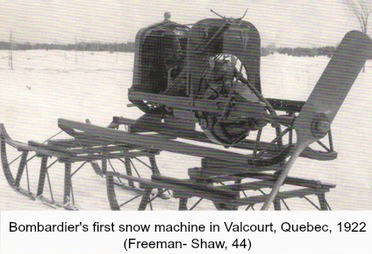
Joseph Armand Bombardier built the first ever snow machine in 1922.
Who used snowmobiles?
Medical personnel, the Royal Canadian Mounted Police, and people in northern communities.
Rate the degree of change:
4 (complete change)
Justification for your rating:
I’d say the snowmobile created a complete change (4) when it first came out. There was no mode of transportation in the north until its development, except on foot (skis or snow shoes) or by dogsled. It also led to the development of a new industry and, later, a new form of recreation. The snowmobile opened up the north, created jobs, and increased mobility and people in northern communities.
The variable pitch propeller
In 1922, Wallace Turnbull invented the variable pitch propeller. Before his invention, “planes could only fly in one gear. This meant that the gear was always set for takeoff.” If the plane had a larger load, it could not get off the ground, so Turnbull’s invention also allowed planes to carry large loads.
Source: Coyler, Jill. Canadian Sources Investigated. Toronto: Emond Montgomery, 2010. 43.
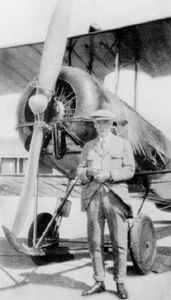
Wallace Turnbull invented the variable pitch propeller in 1922.
Who used variable pitch propellers?
The military used Turnbull’s invention. It was said that his invention “made [the] air-transport industry possible.”
Impact of the invention
Turnbull’s propeller was first tested in flight in 1927. “This device adjusts the angle at which propeller blades cut the air, and it became as essential to aviation as the gearbox is to the automobile. It provides for safety and efficiency at all engine speeds, for example, maximum power on takeoff and landings and economical cruising for long distances.” Hence, Turnbull’s invention has had an enormous impact on air travel.
Rate the degree of change:
4 (complete change)
Justification for your rating:
The degree of change was high: This invention made it possible for airplanes to transport goods because they were then able to lift from the ground while carrying a load. The invention made transportation by air possible, and new services developed. Planes with these propellers could be used by the military and for the transportation of passengers and goods. It was a great step forward for the air transport industry.
Insulin
In 1921, Dr. Frederick Banting and his colleague Dr. Charles Best discovered insulin as a treatment that helps control diabetes because it lowers blood sugar. The doctors tested their invention on dogs, one of which is in the following picture.

Dr. Frederick Banting and his colleague Dr. Charles Best, in 1921, with one of the dogs they used to test their invention of insulin treatments.
Who used insulin?
Diabetics used insulin to control the symptoms of diabetes.
Impact of the invention
The impact of insulin is immeasurable. The first life it saved was that of a 14-year-old boy who was dying at the Toronto General Hospital. Millions of diabetics around the world now use insulin regularly. It allows diabetics to live long, normal lives. Before insulin, diabetics often died young of heart attacks or strokes, or suffered from blindness, amputation of limbs which became infected, and kidney failure.
Rate the degree of change:
4 (complete change)
Justification for your rating:
The degree of change is incontestably high. Before insulin became available as a treatment of diabetes, patients diagnosed with Type I diabetes knew their prognosis was very grim. Insulin has saved the lives of millions of people and helped improve the quality of life of millions of others. It was one of the major medical breakthroughs of the 20th century. (In the 1920s, it also required the creation of a whole new system of manufacturing, packaging, and distribution, and thus created new jobs.)
Join the discussion
What criteria do you use to rate the degree of change resulting from a scientific or technological development? As a class, create a list of criteria. Using the class criteria discuss as a class or small group which development during this period you think is the most significant. Why?
What about women?
The First World War and the 1920s changed the role of women in Canada and in other Western countries. Women made measureable and lasting progress toward social equality during that decade. While it is undeniable that improvements were made, did they change the everyday lives of women in a tangible, dramatic way? In this topic, you will conduct some research in order to voice your own opinion about the changing conditions of women’s lives.
Some say that the 1920s really “roared” for women in Canada. It will be up to you to challenge that statement.
In order to prove or disprove that statement, you will need to conduct some research to find evidence.
You will have to review a variety of sources, both primary and secondary, which are reliable and accurate. You’ll then review the information they provide and select relevant evidence to support your position. Finally, you’ll organize the evidence so it’s easily understood.
As a method of research, you’ll use the inquiry process, which proceeds as follows:
- Develop your research question and record it.
- Write a position statement based on your research question. This is the statement you will prove through research.
- Select sources that contain accurate and trustworthy information, include a variety of viewpoints, and include both primary and secondary perspectives.
- Review the information in your sources for specific, relevant evidence that helps prove your position statement.
- When you find useful evidence, record it. Use your own words to paraphrase the content or select relevant quotations from the source that encapsulate the evidence you need.
- Document the source; that is, record the reference information for the source you used. Keeping a record of the source is necessary in order to identify and acknowledge the originator.
- Organize your evidence/information so the key points you have gathered stand out and support your position statement.
- Summarize your findings.
Now you’ll walk through the research and inquiry process using an example.
The research question is as follows:
- Did the 1920s really “roar” for women in Canada?
The position statement that was developed from the research question is as follows:
- Canadian women made measureable and lasting progress toward social equality during the 1920s – the decade really did “roar” for women in Canada.
Over the next several sections, use the sources of information which have been selected for you to find evidence to support the position statement.
Source 1: Status of Women
Refer to the following excerpt and find evidence that describes what happened to women in the workplace after World War I was over.
Following is an excerpt from an article from The Canadian Encyclopedia, titled “Status of Women (Opens in new window).” This is a secondary source from a reliable website.
Evidence
For this first example, the evidence has been extracted from the source for you. In subsequent readings, you’ll have to identify and record the evidence from the source yourself. You’ll either paraphrase the source (rewrite in your own words to make it simpler) to state your evidence, or use a direct quotation from the source.
You’ll also have to keep a record of the source of this evidence.
In the article that you have just reviewed, what evidence describes what happened to women in the workplace after World War I was over?
Your answer should include the following:
In the years immediately after the war, a lot of women lost their jobs. In the 1920s however, women gained access to new professions, such as social and library work, and even physiotherapy; the majority of positons were still clerical and domestic, “but for the first time in the century the percentage of women working as domestics fell below 20%.” Women also started going to university and, by 1930, women represented 35 percent of all undergraduates.
You’ve just examined how to use a reliable source to find evidence that can support a position statement.
You will also have to cite your source as follows:
Anderson, Doris. “Status of Women.” The Canadian Encyclopedia. Accessed February 7, 2006. http://www.thecanadianencyclopedia.com/en/article/status-of-women/
Source 2: Women: 1921–1930
Following is the second source suggested for this research.
This excerpt from the United Food and Commercial Workers’ Canadian website is titled “Women: 1921–1930 (Opens in new window).” The United Food and Commercial Workers (UFCW) is Canada’s private sector union, and it represents workers in North America, primarily in the food industry. This is a secondary source – it was written after the events occurred.
As you review, find evidence to answer the following question: What do the milestones that women achieved in the 1920s tell you about how their role in society changed during that time?
Evidence
Women achieved many milestones in the 1920s. What do these milestones tell you about how the role of women changed in society during that time? Put the evidence you selected in the space provided using paraphrased text or direct quotation. For this activity, the sources have been documented for you. When you’re doing your own research you’ll keep your own records of sources.
Women arduously fought for their rights after the war had ended. They obtained better working conditions, legal protection, social protection and recognition, and the right to vote. They were recognized as “persons” in 1929, and thereby became eligible for nomination to the Senate. It seems that women truly “came into their own” in a way after the war. Many became aware that they were the equals of men in many respects and that they deserved to be treated as such. Even if much progress still needed to be made after the 1920s (women did not receive equal pay, for example), some might say that this truly marked the first wave of feminism.
Source: “Women: 1921–1929.” UFCW. Accessed October 17, 2014. http://www.ufcw.ca/index.php?option=com_content&view=category&id=33&Itemid=152&lang=en
You’ve just used a reliable source to find evidence to support a position statement, and you’ve documented the source.
Source 3: Miss Lottie Jones’s teacher’s contract, 1923
This is your third source. It is a primary source document: This is a real contract for Miss Lottie Jones, a teacher in 1923.
As you review, find evidence about the status of women. Do some rules in the teacher’s contract surprise or interest you? Do the rules relate to the job of a teacher, or do they indicate something else? Now, examine Miss Lottie Jones’s teacher’s contract in the following section:
TEACHER'S CONTRACT
This is an agreement between Miss Lottie Jones, teacher, and the Board of Education of the Middletown School, thereby Miss Lottie Jones agrees to teach in the Middletown School for a period of eight months beginning September 1, 1923. The Board of Education agrees to pay Miss Lottie Jones the sum of seventy-five dollars per month.
- Not to get married. This contract becomes null and void immediately if the teacher marries.
- Not to keep company with men.
- To be home between the hours of 3pm and 6am unless she is in attendance at a school function.
- Not to loiter downtown in ice cream parlours.
- Not to leave town at any time without the permission of the Chairman of the Board of Trustees.
- Not to smoke cigarettes. This contract becomes null and void immediately if the teacher is found smoking.
- Not to drink beer, wine or whiskey. This contract becomes null and void immediately if the teacher is found drinking beer, wine, or whiskey.
- Not to ride in a carriage or automobile with any man except her brothers or father.
- Not dress in bright colours.
- Not to dye her hair.
- To wear at least two petticoats.
- Not to wear dresses more than two inches above the ankle.
- To keep the schoolroom clean: to sweep the classroom floor at least once daily; to scrub the classroom floor at least once a week with hot water and soap; to start a fire at 7am so that the room will be warm at 8am when the children arrive; to carry out the ashes at least once daily.
- Not to use face powder, mascara or paint the lips.
Source: "1923 Teacher Contract."
http://wrmshistory.wikispaces.com/1923+Teacher+Contract
Evidence
Which rules in the teacher’s contract surprise or interest you? Explain what surprises you. Do the rules relate to the job of a teacher, or do they indicate something else?

Put the evidence you selected in the space provided using paraphrased text or direct quotation. Also keep a record of the source.
Answers will vary, but may include the following:
I thought the rule about not keeping company with men was a surprise. Why wouldn’t the school board want their teachers to date and get married? Did they think it would affect her ability to be an effective teacher? It does not make
sense that she would have to lose her job over that. These rules do not relate to the job of a teacher; rather, they indicate that women were not seen as men’s equals and had to follow very strict behavioural rules, which most probably
didn’t apply to men. Some progress has been made, during the 1920s with regards to the role and status of women – that is undeniable – but much more still had to be done.
Source: “1923 Teacher Contract.” http://wrmshistory.wikispaces.com/1923+Teacher+Contract
Source 4: Flappers
The fourth source is an article from The Encyclopedia.com titled “Flappers.”
Flappers
No decade in recent history has witnessed as much change in the status and style of women as the 1920s, sometimes called the Roaring Twenties or the Era of Wonderful Nonsense. Trendy young women of the 1920s were nicknamed flappers, and the flapper became the image that represented the tremendous change in women's lives and attitudes during that period.
During the early part of the twentieth century women in countries from Australia to Norway were gaining the right to vote, and more and more women were able to support themselves by working at jobs. In addition to women's new freedoms, by the 1920s there were automobiles to drive, films in theatres, and jazz music to dance to, and modern young women wanted to join in the fun. Young women were no longer content to spend hours binding themselves into burdensome layers of clothing or styling long masses of hair.
The term flapper originated in Great Britain, where there was a short fad among young women to wear rubber galoshes (an overshoe worn in the rain or snow) left open to flap when they walked. The name stuck, and throughout the United States and Europe flapper was the name given to liberated young women. Flappers were bold, confident, and sexy. They tried new fad diets in an effort to achieve a fashionable thinness, because new fashions required slim figures, flat chests, and slim hips. The flapper dress was boxy and hung straight from shoulder to knee, with no waistline, allowing much more freedom of movement than women's fashions before the 1920s. While it did not show breasts or hips, it did show a lot of leg, and the just-below-the-knee length horrified many of the older generation. French fashion designer Gabrielle "Coco" Chanel (1883–1971) did much to popularize the new freedom of women’s fashion.
Flappers also shocked conservatives by cutting their hair short and wearing makeup. Before the 1920s long hair was the mark of a respectable lady, but flappers had no time for elaborate hairdos. They cut, or bobbed, their hair just below the ears and curled it in dozens of tiny spit curls with a new invention called a bobby pin. Some also used electric curling irons to create small waves called "marcels," named after Marcel Grateau (1852–1936), the French hair stylist who invented them. Cosmetics had long been associated with prostitutes and actresses, but flappers considered it glamorous to wear dark red lipstick, lots of rouge, and thick black lines around their eyes, sometimes made with the burned end of a matchstick. New cosmetics companies including Maybelline and Coty began manufacturing products to help women achieve this new fashion trend. For the first time, women began to carry cosmetics with them in handbags wherever they went.
One of the most famous flappers was silent film star Clara Bow (1905–1965). Sometimes called the "It" girl, Bow was thought to have "it," a quality of open sexuality, innocence, and fun that was the very definition of the flapper. Many women imitated Bow's appearance by drawing a bow shape on their lips, rimming their eyes in black, and curling their hair onto their cheeks.
Despite the youthful enthusiasm for flapper style, some people felt threatened by it. When hemlines began to rise, several states made laws charging fines to women wearing skirts with hemlines more than three inches above the ankle, and many employers fired women who bobbed their hair.
However, in the excitement and gaiety that followed the end of World War I in 1918, the movement toward a freer fashion could not be stopped by those who valued the old ways. It took the stock market crash of 1929 to bring the era of the flapper to a sudden end. Almost overnight, the arrival of an economic depression brought a serious tone to society. Women's hemlines dropped again, and the carefree age of the flapper was over.
Source: "Flappers." The Canadian Encyclopedia. October 13, 2004.
http://www.encyclopedia.com/doc/1G2-3425500477.html.
As you review evidence of a new, emerging style of woman, what was it about these women that shocked conservative people at the time? What does the emergence of this style in the 1920s tell you about the changing roles of women and how they were perceived at the time?
Evidence
Since the term “flappers” describes a new style of woman that shocked the more conservative sensibilities of the time, what does the emergence of such a style in the 1920s tell you about the changing roles of women and how they were perceived at the time?
Answers will vary, but may include the following:
It seems like some women were feeling free and bold enough to try some very new and unconventional things, such as cutting their hair short, wearing makeup, and experimenting with a “freer” sense of fashion. This shows that women at the
time felt more free and empowered, and that they didn’t accept to suppress their sense of self anymore. On the contrary, some women appeared resolved to express the feminine side of their identity. However, it always takes time for
society to adapt to new norms and to get comfortable with a move away from conservatism, and the “flappers” were often met with skepticism and/or rejection.
Source: “Flappers.” Encyclopedia.com. 2004. http://www.encyclopedia.com/doc/1G2-3425500477.html.
Source 5: The Person’s Case
Following is the fifth and final source suggested for this research. It is an article from the website of the University of Calgary, titled “The Person’s Case (1929) (Opens in new window).”
As you examine the source, try to find evidence about what these five women achieved.
Evidence
What did the Famous Five – Henrietta Muir Edwards, Nellie McClung, Louise McKinney, Emily Murphy, and Irene Parlby – achieve for Canadian women through The Person’s Case?
Answers will vary, but may include the following:
They fought so that Canadian women could be legally recognized as persons, allowing women to hold political office and be admitted into public service roles. The achievement of personhood for women must have been very empowering, and it
probably encouraged many women to assert themselves and become more confident. The Famous Five have become a symbol of what can be achieved through persistent activism, and their relentless quest to improve the conditions of women shows
how great their contributions to women’s rights truly were. After conducting some of my own research, I discovered that I strongly disagreed, however, with the stance some of them took on certain issues, such as immigration regulations
for non-white immigrants and the introduction of eugenics in Canada.
Source: “The Person’s Case (1929).” Global Perspectives on Personhood. http://people.ucalgary.ca/~gpopconf/person.html
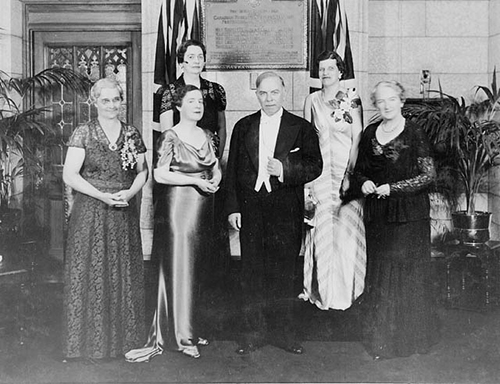
The unveiling of a plaque commemorating the five Alberta women whose efforts resulted in the Person’s Case, which established the rights of women to hold public office in Canada.
Draw your own conclusions
You have just explored five sources. What questions might you still have? What topics might still need to be explored before best weighing your evidence?
Note that the question asks: "Did the 1920s really “roar” for women in Canada?"
It is important to note that some women may have not benefitted from the same progress in rights as other women. Consider some of your learning from previous learning activities about:
- Voting rights
- Policies affecting Indigenous peoples
- Immigration
It can be challenging to draw conclusions from evidence when studying history. Sometimes you use reliable sources and find evidence that is all true, but one source can contradict another. What do you do with contradictory facts?
The answer is that you weigh the evidence and come up with what you think is the best, most balanced interpretation that you can.
Notebook
Now that you have examined some evidence, do you think that the 1920s really “roared” for women in Canada? In other words, did the status of women in Canada improve in the 1920s?
Your answer should be three or four sentences long. Share with a partner to determine whether you agree, or not. And, discuss how you came to your conclusions.
What was Prohibition?
Prohibition was the legal act that made the manufacture, transportation, sale, purchase, and consumption of alcohol illegal. Why Prohibition? To understand the causes and consequences, it helps to use the historical thinking concept of historical perspective.
[Having] “historical perspective means attempting to see through the eyes of people who lived in times and circumstances sometimes far removed from our present-day lives.” It’s also important to note that there can be an “ocean of difference…between current worldviews (beliefs, values, and motivations) and those of earlier periods in history.”
The following excerpt is an explanation of Prohibition from an article titled “Prohibition and Temperance.” It will give you an idea of the different attitudes toward alcohol in those times.
In early-twentieth-century Canada, liquor was widely considered unhealthy, and the sale of liquor was seen as exploiting the poor and morally weak individuals who could not resist the call of the local saloon (Smart and Osborn 1996: 28). Political cartoons of the time often presented liquor sellers as predators or scavenger birds looming ominously over young men or children, while drinkers were presented as sick, often violent moral degenerates who squandered the resources of their families on the bottle. At the center of these beliefs was the moral concept of “temperance” – a mindset summed up in the maxim “moderation in all things healthful; total abstinence from all things harmful” (Xenophon cited in WCTU 2008). In early 1900s Ontario, temperance groups were a strong political force, and had succeeded in pressing their ideas into the mainstream.
These beliefs are also presented in the following political cartoon. Examine the cartoon, then interpret it based on the question afterward.
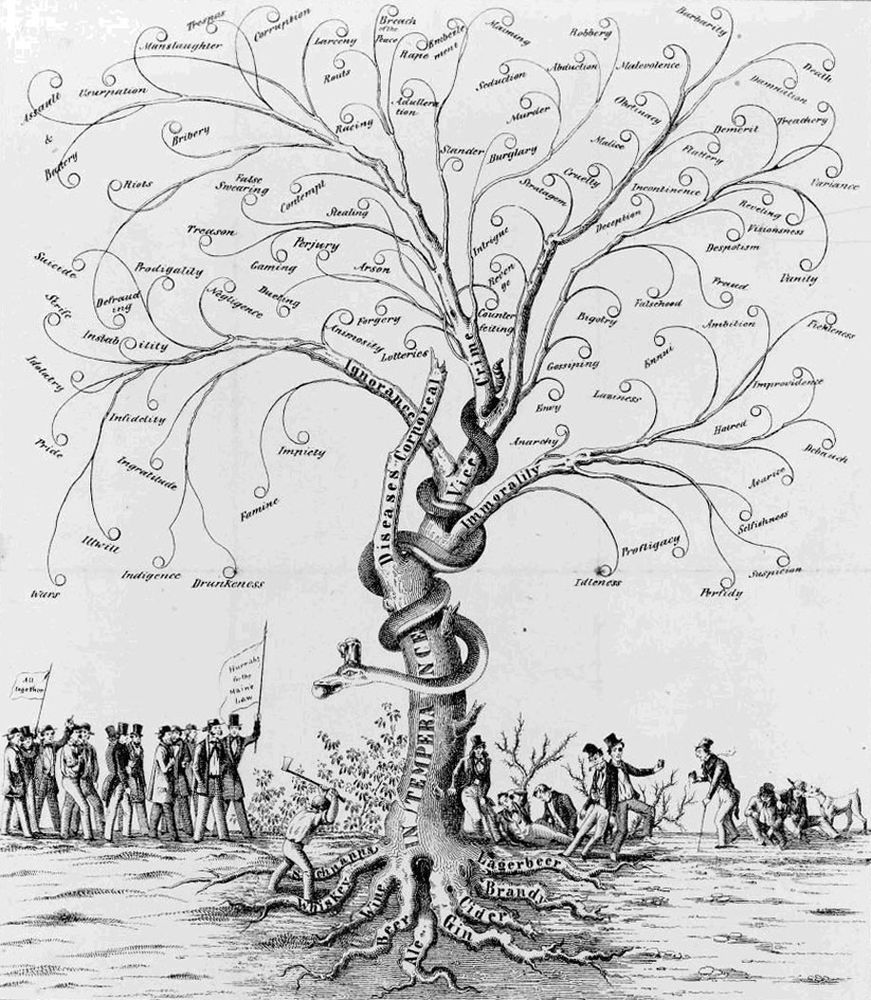
The word “intemperance” is used to label the tree. What does intemperance mean? What sort of things make up the “roots” of the intemperance tree?
Intemperance means lack of moderation. If you have an intemperate personality, you allow yourself the indulgence of alcohol, for example. The roots of the tree represent different kinds of alcohol – ale, beer, gin, cider, wine, etc.
What five “evils” make up the main branches of the intemperance tree? (Corporeal means “of the body.”)
Vice, disease, ignorance, crime, and immorality.
What do the people on the left represent? What about the people on the right?
The people on the left are the people who abstain from alcohol. They are prohibitionists; they are represented as clean and healthy. The people on the right are drunks. They are represented as sick and dirty.
What animal is wrapped around the tree? What is in its mouth? On its head? Why is this animal represented in the cartoon?
A snake is wrapped around the tree. It has an apple in its mouth and a beer mug filled with beer on its head. A snake is represented here because snakes are commonly associated with the devil/evil.
What is the main message of this political cartoon?
Intemperance comes in many forms and has many negative effects (shown by the branches). Cutting the tree down (shown by the man with the axe) is like putting an end to intemperance and its negative effects.
Join the discussion
Research another political cartoon about prohibition. Post your cartoon to the discussion forum.
Read and analyze each cartoon posted by other students.
Then, choose three cartoons to respond to. Answer the following questions in your notebook:
What is it trying to say?
What message is being conveyed?
What can we learn about Prohibition from the cartoon?
Although Prohibition had many fans, not everybody supported it. The following reading titled “Prohibition – “Wet” Voices” lists a few alternative opinions from those known as “wet” voices – those who believed that alcohol should not be illegal.
Prohibition – "Wet" Voices
The Ontario Personal Liberty League:
"The real point is whether there is any personal freedom which the majority is bound to respect. For if such majority can decree what men shall and shall not drink, why not what they shall and shall not wear, how they shall and shall not vote, and how they may and may not worship God?"
The Parkdale Branch of Toronto's Great War Veterans' Association:
"Having resisted the tyranny of [Kaiser] Wilhelm, [we do not] propose to submit to the meanest of all tyrannies, the tyranny of petticoat government." (Petticoat government is undoubtedly a reference to the WCTU or women in general who fought for Prohibition and won. A petticoat is a female undergarment. The implication is that only women, not men, favoured Prohibition.)
A British Columbian Veteran:
"Drinking is a social custom of man, just as tea drinking is a social custom of women. We don't interfere with their custom, so don't let them interfere with ours."
The Ontario Moderation League:
"A temperance country can be more surely obtained by evolution than by legislation and…total prohibition is inconsistent with true temperance and opposed to Christian morality."
Source: Freeman-Shaw, Elizabeth and Jan Haskings-Winner.
Canadian Sources Investigated.
Toronto: Emond Montgomery, 2008. 27.
Think
What are some of the sexist attitudes that are apparent in these quotes?
What connections can you make between these attitudes and other occurrences you have learned about during this time period?
In the end, the Canadian government gave provincial governments authority to decide on Prohibition for themselves. Prohibition did not last long in any province/territory of Canada with the exception of PEI where it lasted 47 years. Quebec’s Prohibition, by contrast, lasted less than one full year! Refer to the following table that lists the duration of the Prohibition for each province/territory in Canada.
|
Province/territory |
Provincial Prohibition enacted |
Repealed |
|---|---|---|
| British Columbia | 1917 | 1921 |
| Alberta | 1916 | 1924 |
| Saskatchewan | 1917 | 1925 |
| Manitoba | 1916 | 1921 |
| Ontario | 1916 | 1927 |
| Quebec | 1919 | 1919 |
| New Brunswick | 1917 | 1927 |
| Nova Scotia | 1921 | 1929 |
| PEI | 1901 | 1948 |
| Yukon | 1918 | 1920 |
| Newfoundland (not part of Canada until 1949) |
1917 | 1924 |
While Prohibition was in effect, it spawned an entirely new sort of “job” for some Canadians: bootlegging. Bootleggers, also known as “rum runners” made and/or sold alcohol. Sometimes they sold the alcohol within Canada, but mostly they sold it to the United States.
In 1920, the U.S. amended their constitution to make the production, transport, and sale of alcohol illegal. This was the 18th Amendment and it “inspired” some Canadians to make money by selling illegal liquor to their American neighbours.
Review the following photos to examine images of scenes from the beginning, middle and end of Prohibition. You’ll also examine how bootlegging took on many different forms.
Notebook
Do you find value in prohibition? Do you think this could ever happen today? Why or why not? Record your answers in your history notebook.
Arts, entertainment, and leisure
The twenties did “roar” in the arts and entertainment industry. Because the economy was booming, Canadians had money to spend on luxuries such as entertainment. In the following section, explore some of the new art, entertainment, and leisure activities that were popular in the 1920s.
Review
How were the 1920s similar to today, and how were they different, in regard to arts leisure, and entertainment?
Assessment Opportunity
Primary and Secondary Sources Discovery
Your turn: Choose one of the following individuals or events:
- Mazo de la Roche
- Stephen Leacock
- Tom Longboat
- John McCrae
- the racing career of the Bluenose
- the founding of the National Hockey League and the Ladies Ontario Hockey Association
- Montreal's emerging jazz scene
- the Asahi baseball team
Your task is to find at least one primary source and at least one secondary source that will help you investigate the following research question:
What contribution did this individual or event make to arts and popular culture in Canada during this period? You will be citing the source, and analyzing its credibility, and writing a summary of what you found in your investigation, to help you address the research question. You may be asked to share what you found with the class.
In your notebook recreate this organizer to record your research findings.
| Primary Source Document: (provide screenshot or link) |
Empty cell to be completed |
|---|---|
| Citation: | Empty cell to be completed |
| I believe this source is credible because: | Empty cell to be completed |
| What does this source tell me about the research question? Provide a summary of information from this source (maximum 100 words) | Empty cell to be completed |
| Secondary Source Document: (provide link) |
Empty cell to be completed |
|---|---|
| Citation: | Empty cell to be completed |
| I believe this source is credible because: | Empty cell to be completed |
| What does this source tell me about the research question? Provide a summary of information from this source (maximum 100 words) | Empty cell to be completed |
Next, answer the following question:
From these sources, I believe this individual or event made a significant change in the arts and popular culture in Canada during this period because....
(maximum 150 words)
Feedback and marking
You may receive the following forms of feedback:
- Your teacher may highlight the phrases on the rubric that best describe your assignment to show you how you have done.
- Your teacher may also provide you with detailed comments about the strengths of your assignment, the areas of the assignment that need improvement, and the steps you should take before submitting another assignment like this one.
Rubric – Primary and Secondary Sources Discovery
Pay careful attention to the following rubric. Your teacher will use it to assess your work. You should refer to it too, so you’ll know exactly what your finished assignment should look like.
Success Criteria:
- I can correctly select a primary source document in my research. (A1)
- I can correctly select a secondary source document in my research. (A1)
- I can correctly cite my sources. (A1)
- I can correctly identify the credibility of a source to use for research. (A1)
| Level 4 | Level 3 | Level 2 | Level 1 |
|---|---|---|---|
| With a high degree of effectiveness | With considerable effectiveness | With some effectiveness | With limited effectiveness |
Success Criteria:
- I can evaluate and synthesize the information from my sources the sources to help me address the research question in my summary. (A1)
| Level 4 | Level 3 | Level 2 | Level 1 |
|---|---|---|---|
| With a high degree of effectiveness | With considerable effectiveness | With some effectiveness | With limited effectiveness |
Success Criteria:
- I can clearly communicate the summary of my findings to address the research question given. (A1)
| Level 4 | Level 3 | Level 2 | Level 1 |
|---|---|---|---|
| With a high degree of effectiveness | With considerable effectiveness | With some effectiveness | With limited effectiveness |
The teacher will assess your work using the rubric. Before submitting your assessment, review the rubric to ensure that you are meeting the success criteria to the best of your ability.
The 1920s are sometimes referred to as the “Roaring Twenties” because the economic prosperity of the period led to the emergence of many technological innovations and new forms of entertainment. The status of women also vastly improved. Women were legally ruled to be persons and thereby acquired the right to be appointed to the Senate; they also got the right to vote and to get a divorce on the same grounds as a man. New work and career avenues opened up for women, and they started attending university in greater numbers. During the 1920s, Canadian women took a bold step toward more independence and a stronger sense of self and confidence.
Much progress remained to be done, however, so women could become men’s equals in the eyes of society (and it still does today). Most women did not experience a significant improvement in political or economic opportunity. They continued to be paid less than men and, despite the famous “flapper” image, many women were restricted by old standards of behaviour. Furthermore, not all women experienced the improvements that came in this decade. In the 1920s, improvements for women were inequal along racial lines.
Canada’s working classes did not fully share in the prosperity of the urban elites. Some workers still had few rights, worked in poor conditions, and still received low salaries. Their standards of living had increased, but work continued to demand long hours and there was still little time for leisure.
Moreover, many men were prone to alcohol abuse, and this resulted in financial hardship for a lot of families, as men still remained the main wage earners of a household most of the time. Prohibition came about after decades of work by temperance workers (who promoted temperance, abstinence, and prohibition), many of whom were women. In the end, Prohibition didn’t last long enough to have an enduring effect, but it did allow and motivate women to voice their opinions and get involved in political causes.
The 1920s were packed with change – increased industrialization and urbanization, the growth of mass entertainment and sports, and other social and cultural changes; but this was also a decade of struggle, and not everyone enjoyed “boom” times.
Join the discussion
To summarize your learning, discuss as a class: Is the ‘Roaring Twenties’ an appropriate name for this decade? Why or why not?
Consider which groups in Canada benefitted from the Roaring Twenties and which did not.




